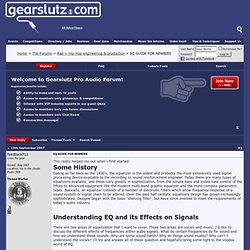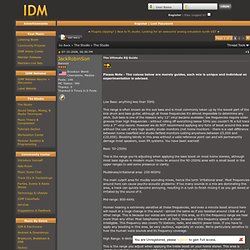

Audiotuts+ Five Frequency Areas When EQ'ing the Vocal. Equalizing a vocal track can be very tricky.

Sometimes it seems to sound like it was stuck on later, and doesn't flow with the rest of the track. Below are the five frequency ranges you can start with when you are in trouble and need to figure out how to equalize it so it sits with the song. It goes without saying that no amount of EQ'ing is going to fix a badly recorded vocal. So be sure to have a clean and well recorded vocal before you start mixing it. 15 Online Tools that You Will Come to Love as a Tech. I have compiled a list of 15 free online tools that will help you greatly as a tech.

I’m sure that there are other good ones that I have left out so please feel free to post the ones that you like as well. IPTools offers a wide variety of online networking tools. With this site you can look up IP address information, check spam databases, run pings, run traceroutes, lookup WHOIS information and much more. BugMeNot allows you to find and share logins for sites that require you to register. This tool is great to use when you don’t want to have to go through the process of creating an account for a site when you just want to login once for something like a driver. SpeedTest.net allows you to test your Internet connection speed. Del.icio.us is a social bookmarking site that allows you to bookmark sites and view them from any computer.
Omnidrive is an online storage service that allows you to upload large files, access them from any computer, and share them with other people. Welcome to RecProAudio - DIY Pro Audio Equipment - La2a, Pultec, MC76, Tweed Deluxe, Active and Tube DIs, Redd.47 Info. Audio Engineering Society (AES) Pro Tools. TT Dynamic Range Meter - Fight the Loudness War. ( Or, how to NOT smash it to hell !

) Update – I wrote this post a few years ago now, and the TT meter is no longer the only kid on the block – although it’s still a great choice. To see a new video round-up of some currently available dynamic range meters, click here . Loudness has always been an important topic in mixing, and especially mastering – never more so than today. Knowing how loud is too loud has always been difficult. Recently a new tool has been released, purpose-designed for measuring the loudness of music. And best of all – it’s free . (*) (*) Kind of This tool is the TT Dynamic Range Meter , released by the Pleasurize Music Foundation . There is also a second, off-line version of the meter, which generates an overall DR dynamic range measurement for a complete WAV file or CD and allows you to generate a log file, which can be submitted to the (unofficial) Dynamic Range Database .
How it works How to read the meter It’s that simple ! (Well actually, it’s not quite that simple. Interactive Frequency Chart - Independent Recording Network. EQ GUIDE FOR NEWBIES. This really helped me out when i first started.

Some History Dating as far back as the 1930's, the equalizer is the oldest and probably the most extensively used signal processing device available to the recording or sound reinforcement engineer. Today there are many types of equalizers available, and these vary greatly in sophistication, from the simple bass and treble tone control of the fifties to advanced equipment like the modern multi-band graphic equalizer and the more complex parametric types. Basically, an equalizer consists of a number of electronic filters which allow frequency response of a sound system or signal chain to be altered.
Over the past half century, equalizers design has grown increasingly sophisticated. Designs began with the basic 'shelving filter', but have since evolved to meet the requirements of today's audio industry. Understanding EQ and its Effects on Signals There are two areas of equalization that I want to cover. Vocals Effects of Equalization on Vocals. The Ultimate EQ Guide. Please Note - The values below are merely guides, each mix is unique and individual so experimentation is advised.

Low Bass: anything less than 50Hz This range is often known as the sub bass and is most commonly taken up by the lowest part of the kick drum and bass guitar, although at these frequencies it's almost impossible to determine any pitch. Sub bass is one of the reasons why 12" vinyl became available: low frequencies require wider grooves than high frequencies - without rolling off everything below 50Hz you couldn't fit a full track onto a 7" vinyl record. However we do NOT recommend applying any form of boost around this area without the use of very high quality studio monitors (not home monitors - there is a vast difference between home nearfield and studio farfield monitors costing anywhere between £5,000 and £20,000). Boosting blindly in this area without a valid reference point can and will permanently damage most speakers, even PA systems.